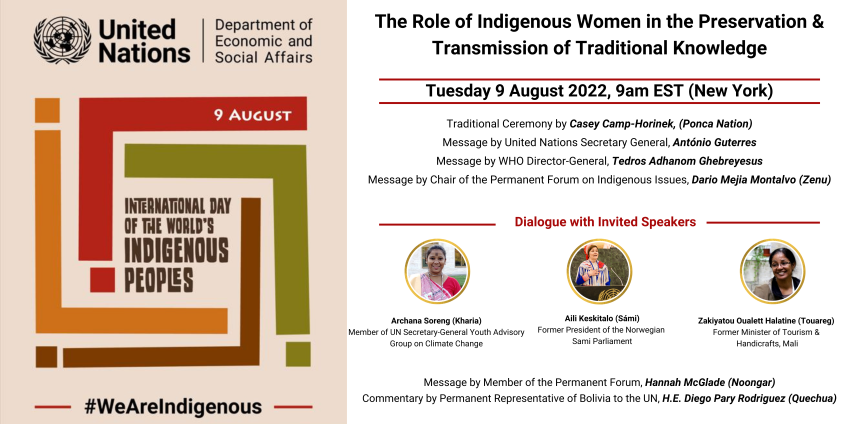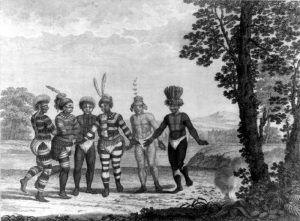International Day of the World’s Indigenous Peoples

The International Day of the World’s Indigenous Peoples is celebrated globally on 9 August. It marks the date of the inaugural session of the Working Group on Indigenous Populations in 1982. This year’s theme: “The Role of Indigenous Women in the Preservation and Transmission of Traditional Knowledge”. Indigenous women are the backbone of indigenous peoples’ communities and play a crucial role in the preservation and transmission of traditional ancestral knowledge. They have an integral collective and community role as carers of natural resources and keepers of scientific knowledge. Many indigenous women are also taking the lead in the defense of lands and territories and advocating for indigenous peoples’ collective rights worldwide.
In the San Francisco Bay Area Sogorea Te’ Land Trust an urban Indigenous women-led land trust that facilitates the return of Indigenous land to Indigenous people.

For thousands of years, hundreds of generations, the Lisjan Ohlone people have lived on the land that is now known as the East Bay in the San Francisco Bay Area. Sogorea Te’: “We did not own the land, we belonged to it. Generation after generation, we have cultivated reciprocal relationships with the plants and animals we share this place with and developed beautiful and powerful cultural practices that keep us in balance. Through the practices of rematriation, cultural revitalization and land restoration we are working to restore a people to their rightful place in sacred relationship with their ancestral land. Sogorea Te’ calls on Native and non-native peoples to heal and transform the legacies of colonization, genocide, and patriarchy and to do the work our ancestors and future generations are calling us to do.”

In the heart of deep East Oakland, Lisjan is a traditional village site and the first piece of land rematriated by Sogorea Te’ within the territory of Huchiun.
The Ohlone traditionally lived in independently organized villages. They survived by hunting, fishing, and gathering acorns and seeds. They lived in round houses made of a framework of poles covered with grass, tule reeds, or ferns. They traveled the water in boats made of balsa wood or on rafts of tules.

Three Ohlone people in a tule boat in the San Francisco Bay, painted by Louis Choris in1816
Coyote Hills Park Visitor Center, in Fremont, contains an educational exhibit that portrays the Ohlone way of life before colonialization and include a tule reed boat constructed by park staff and volunteers using Native American methods. Other exhibits cover the park’s natural history and wildlife of the time when the Ohlone lived free and held the land scared. The park hold an annual Gathering of Ohlone Peoples highlights the ways today’s Ohlone’s are bringing their cultures into the future.
The Sogorea Te’ Land Trust is part of the Confederated Villages of Lisjan which is one of many Ohlone nations, each with its own geography and history. The Confederated Villages of Lisjan speak the language Chochenyo. Sogorea Te’: “To honor the land we need our songs; to sing our songs we need our language.
“An essential part of our work of rematriation is regenerating and returning to the cultural knowledges and practices that were lost in colonization. We are revitalizing the rich cultural and spiritual traditions of our ancestors through our projects and everyday practices. Mak Noono Tiirinikma, our language awakens in Chochenyo, is a multi-generational language and cultural revitalization project that breathes new life into Chocheny ”

“The Lisjan are made up of the six nations that were directly enslaved at Mission San Jose in Fremont, CA and Mission Dolores in San Francisco, CA: Lisjan (Ohlone), Karkin (Ohlone), Bay Miwok, Plains Miwok, Delta Yokut and Napian (Patwin). Our territory includes 5 Bay Area counties; Alameda, Contra Costa, Solano, Napa and San Joaqui.” Sogorea Te’
The first Spanish missionaries arrived in the area in 1769, and dramatically change the lives of the Ohlone Indians. Seven Spanish missions were built in their territory between 1770 and 1797. These included San Carlos, Soledad, San Juan Bautista, Santa Cruz, Santa Clara, San José, and Dolores (San Francisco).
In 1834, the Mexican government ordered all Californian missions land and property turned over to the government for redistribution. Before this time, 73 Spanish land grants had already been deeded in all of Alta California, but at this time most lands were turned into Mexican-owned rancherias. The Ohlone became the laborers and vaqueros (cowboys) of Mexican-owned rancherias
As the wave of migrants from the United States started to settle inland California during the Gold Rush, conflicts between the Native Californians and the settlers started to arise. The series of massacres, battles, and wars between the United States and the indigenous peoples of California lasting from 1850 to 1880 is referred to as the California Indian Wars.
During the end of the 19th century and the beginning of the 20th century, the government attempted to force the indigenous peoples to break the ties with their native culture and tribalism and assimilate with the white society. In California, the federal government established such forms of education as the reservation day schools and American Indian boarding schools. The Native American community recognized the American Indian boarding schools to have oppressed their native culture and demanded the right for their children to access public schools. In 1935 the restrictions that forbid the Native Americans from attending public schools were officially removed.
Since the 1920s, various Indian activist groups were demanding that the federal government fulfil the conditions of the 18 treaties of 1851–1852 that were never ratified and apparently, were classified. In 1944 and in 1946 the native peoples brought claims for reimbursements asking for compensations for the lands affected by treaties and Mexican land grants. They won $17.5 million and $46 million, respectively. In the 1960s and 70s, gave rise to red power along with black power and women power that agitated for equality inclusion in American Democracy.
The Ohlone were reduced to less than ten percent of their original pre-mission era population by all estimates. By the early 1900s, they numbered only about 25-30, most of whom lived a “Mexican” life rather than Indian. Throughout the 20th century, the population of indigenous peoples of California gradually rose.
Lisjan families survived the extermination policies by the United States by isolating themselves and concealing their identities. Cultural and spiritual traditions were forced into dormancy or secrecy, and much knowledge perished with the passing of generations. Despite these concerted efforts to erase their history and identity, many Ohlone descendants are actively involved in preserving and revitalizing their native culture and protecting ancestral sites.
 Ann Marie Sayers, Ruth Orta, Corrina Gould and Caleen Sisk at Living On Ohlone Land, Photo by Christopher McLeod
Ann Marie Sayers, Ruth Orta, Corrina Gould and Caleen Sisk at Living On Ohlone Land, Photo by Christopher McLeod
Despite the crucial role indigenous women play in their communities worldwide as breadwinners, caretakers, knowledge keepers, leaders and human rights defenders, they often suffer from intersecting levels of discrimination on the basis of gender, class, ethnicity and socioeconomic status. Their right to self-determination, self-governance and control of resources and ancestral lands have been violated over centuries.
Small but significant progress has been made by indigenous women in decision-making processes in some communities. They are leaders at local and national levels, and stand at the frontlines of defending their lands, their cultures, and their communities. The reality, however, remains indigenous women are widely under-represented, disproportionately negatively affected by decisions made on their behalf, and are too frequently the victims of multiple expressions of discrimination and violence.
The Committee of the Convention on the Elimination of all Forms of Discrimination Against Women (CEDAW) highlighted some of the major issues encountered by indigenous women, particularly noting the high levels of poverty; low levels of education and illiteracy; limitations in access to health, basic sanitation, credit and employment; limited participation in political life; and the prevalence of domestic and sexual violence.
The Local Peace Economy would like to celebrate honor and support the Women of Sogorea Te’ and all Native Women lead groups who are working to restore a people to their rightful place in sacred relationship with their ancestral land. We join with Sogorea Te’ calls on Native and non-native peoples to heal and transform the legacies of colonization, genocide, and patriarchy and to do the work our ancestors and future generations are calling us to do.”

At a celebration of the first official Indigenous Peoples’ Day in San Francisco October 201 , members of the Muwekma Ohlone Tribe stand alongside Mayor London Breed, Board of Supervisors president Malia Cohen, and Board of Supervisors member Vallie Brown. By Pax Ahimsa Gethen – Own work, CC BY-SA 4.0,
The Department of Economic and Social Affairs (DESA) is organizing a virtual commemoration of the International Day from 9 am to 11am (EST) on Tuesday, 9 August 2022

References
To learn more about the park’s history and natural wonders, or naturalist-led walks and other programs, visit the Visitor Center Wednesdays through Sundays, 10am – 4pm.
Learn more about the Great Work that Native People are Doing Throughout the Bay Area [PDF]
Homepage – The Sogorea Te Land Trust
© Kathy Weiser-Alexander/Legends of America, updated November 2021.
Wipedia: Ohlone People









